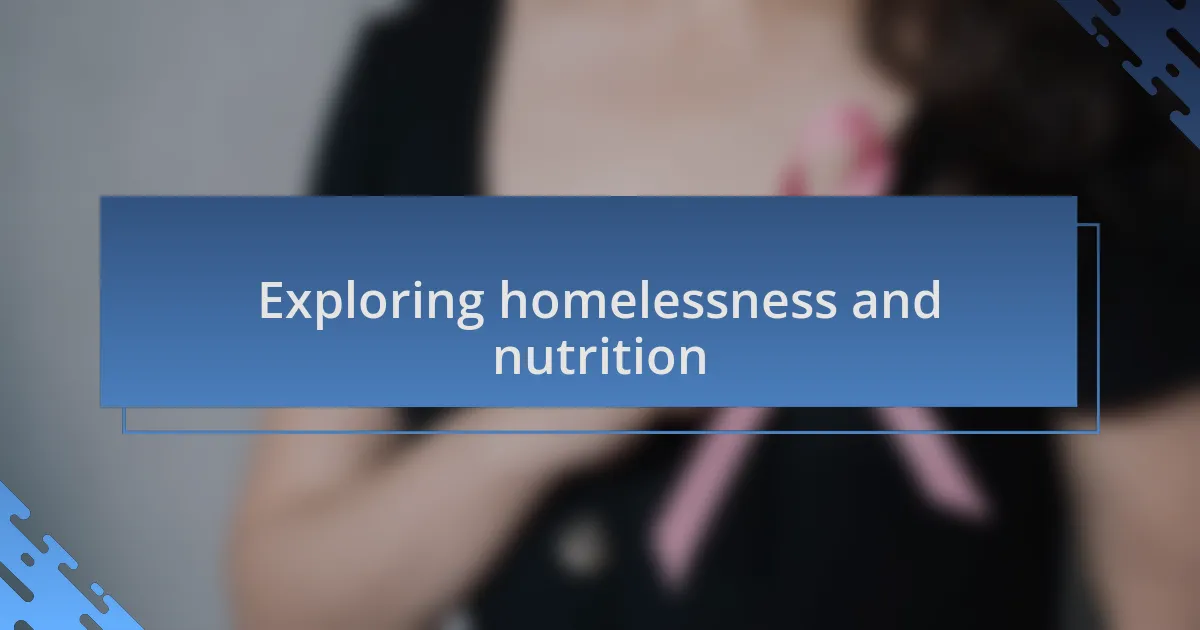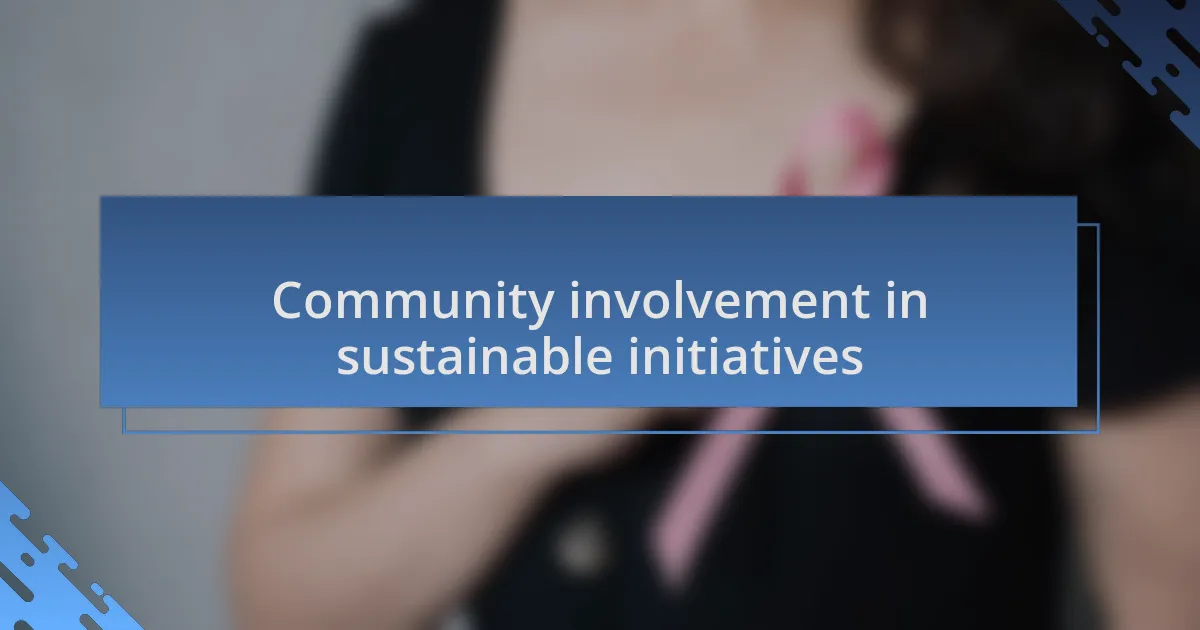Key takeaways:
- Sustainable eating combines health and environmental consciousness, emphasizing the importance of local produce and reducing food waste.
- Access to nutritious meals is crucial for individuals experiencing homelessness, as it empowers them to regain health and dignity.
- Utilizing seasonal ingredients, bulk buying, and repurposing leftovers are effective strategies for sustainable meal planning.
- Community involvement in sustainability initiatives fosters education, camaraderie, and a collective effort to reduce waste and nourish those in need.

Understanding sustainable eating
Sustainable eating means making choices that are kind to both our health and the planet. I remember the first time I purchased local produce at a farmer’s market; it felt almost sacred to support local farmers while knowing that I was cutting down on the carbon footprint associated with food transport. Have you ever thought about where your food comes from? It’s fascinating to consider that a simple meal can have a story that connects us to the land and those who cultivate it.
In my journey, I discovered that sustainable eating isn’t just about what we consume but also how we think about consumption. For instance, when I learned about the environmental impact of food waste, I felt a sense of urgency to change my habits. It’s heart-wrenching to think that millions go hungry while we toss away perfectly good food. How can we reconcile that? Each time I transformed leftovers into a delicious new dish, I felt a connection to both my kitchen and the larger ecosystem.
Another aspect of understanding sustainable eating is the balance it brings to our diets. By focusing on whole, plant-based foods, I noticed not only an improvement in my energy levels but also a deeper appreciation for the flavors of nature. Have you tried cooking with ingredients that are in season? It’s like uncovering a hidden gem in your own neighborhood, reminding us that eating sustainably can be both a delightful adventure and a responsible choice.

Exploring homelessness and nutrition
Exploring homelessness and nutrition requires us to understand the unique challenges faced by those without stable housing. I remember volunteering at a local shelter and being struck by the wide range of dietary needs—often overlooked by the wider community. Have you ever thought how important it is for individuals experiencing homelessness to have access to nutritious meals? It’s not just about filling stomachs; it’s about empowering people to regain their health and dignity.
The nutritional gaps faced by homeless individuals significantly impact their physical and mental well-being. For instance, I often witnessed how clients gravitated toward high-calorie, low-nutrient foods, primarily because those options were more accessible. In a society where fresh produce might be a luxury, how can we expect anyone to thrive? This reality prompted me to advocate for better food programs, recognizing that healthy eating should be a right, not a privilege.
Even small adjustments in food access can lead to meaningful changes. I recall a time when our team introduced a cooking class at the shelter, focusing on simple, nutritious recipes that utilized available pantry items. This was more than just nourishment; it built a sense of community and hope among participants. Isn’t it inspiring to think about how proper nutrition can provide a pathway to healing and stability for those who feel invisible? It’s a reminder that we all share a responsibility to uplift one another through the power of good food.

Strategies for sustainable meal planning
When planning sustainable meals, I focus on utilizing seasonal ingredients. During a recent community garden project, I learned how much flavor and nutrition can come from fresh, locally-grown produce. Not only does this support local farmers, but it also reduces the carbon footprint associated with transporting food long distances. Have you ever tasted a tomato that was picked at its peak ripeness? The difference is remarkable, and those fresh flavors can transform otherwise ordinary meals.
Embracing bulk buying is another strategy I’ve found invaluable. I remember walking into a bulk food store for the first time, overwhelmed yet excited by the options. By purchasing grains, legumes, and spices in larger quantities, I not only saved money but also cut down on packaging waste. It’s empowering to know that small, conscious choices like these can have a ripple effect on our environment. Have you considered the impact of reducing single-use plastic in your own meal planning?
Lastly, I believe in a flexible meal plan that includes leftovers. I’ve often repurposed last night’s vegetable stir-fry into a hearty soup the next day. This practice not only minimizes food waste but also encourages creativity in the kitchen. Isn’t it fun to give new life to what might otherwise be discarded? I find that this approach fosters a sense of resourcefulness and connection to the food I prepare, igniting a deeper appreciation for sustainability.

Community involvement in sustainable initiatives
There’s something incredibly uplifting about watching a community come together for sustainable initiatives. Last spring, I joined a neighborhood clean-up event that focused not just on beautifying our local park but also on educating participants about composting and recycling. Seeing families enthusiastically discuss how they could reduce waste in their homes reminded me that collective action can lead to significant change. Can you imagine the impact if we all took a little time to educate each other on these practices?
Participating in community workshops has been another eye-opener for me. I recall attending a cooking demo centered on plant-based recipes that featured foods sourced from local vendors. The energy in the room was infectious, and it felt empowering to learn practical cooking skills alongside neighbors. What struck me most was how sharing recipes not only fostered a sense of camaraderie but also highlighted the benefits of supporting sustainable agriculture. Have you ever experienced how food can bring people together while promoting eco-friendly practices?
Volunteering at local food banks has also shown me the importance of sustainable community initiatives. Many of these organizations are now prioritizing sustainable sourcing and reducing food waste. I remember sorting through boxes of produce and discovering surplus fruits that were still perfectly good to eat. It sparked a realization about the value of every single item and how community efforts can reclaim food that otherwise would go to waste. Isn’t it powerful to think that by working together, we can nourish those in need while respecting our planet?